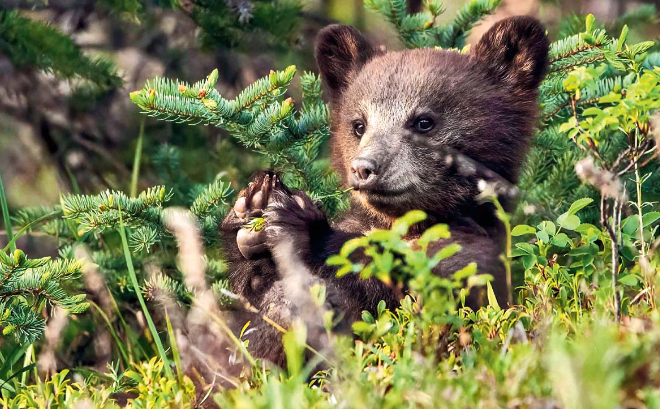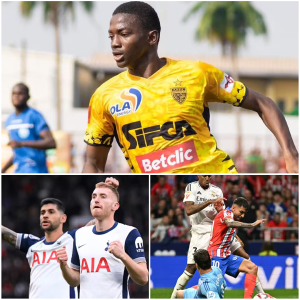
A few years ago, someone broke into my family’s cabin. They came in through a window, and rifled through the fridge. They ate some butter and carried a litre of milk outside. They drank the milk and tossed the empty carton on the ground. Pfft. Not only did this person steal from us, they littered in the woods, which felt like an extra kick in the pants. Except, we later found out, from chatting with others on the lake, that the intruder was a young bear—it had been pulling the same fridge-opening, food-stealing stunts at other cottages.
If you’ve been reading this magazine for a while, you know that bears—and other cottage-country wildlife—can learn all kinds of skills if doing so gets them what they want (usually food). Operant conditioning, where an animal modifies its behaviour in response to punishments or rewards, “plays a role in learning for almost every single species,” says Hannah Griebling, a PhD candidate with UBC’s Animal Behaviour and Cognition Lab. But the learning begins way before animals have any interaction with us.
In many ways, animals learn the same way we learn. “We’re more similar than we are different,” says Griebling. “A lot of the mechanisms and milestones are the same, especially in the early stages of development.” All babies need to learn how to move, how to feed themselves, how to interact with others—in other words, how to successfully live in the world. They don’t watch Sesame Street or go to kindergarten. But the lessons do begin early.
1) They learn from their mamas (and their daddies)
A key first skill for a youngster to master? How to feed yourself. Take baby loons, for example. “It takes at least eight weeks before young common loons can catch a good portion of their own food,” says Doug Tozer of Birds Canada. First, the adults bring their young the fish, then the adults “help” the babies by dropping the fish near the young. “Often the young miss or fumble the fish, and then the adult recaptures the fish and offers it again,” he says.
Similarly, parents feed their songbird nestlings until the babies fledge. After that, “there’s a transitional period,” says Carrie Branch, an assistant professor in the psychology department at Western University, in London, Ont. “The babies follow their parents around, screaming at them.” (Where my food at?!) At this point, they can witness their parents finding food. But it takes a cognitive leap for the offspring to bridge the gap between what they want and how they’re supposed to get it. Branch describes a video of a baby robin attempting to catch a worm. The youngster hops around, mouth open, expectantly following the meal. “At some point, the bird has to figure out how to get that worm into its mouth,” says Branch.

Wild Profile: Meet the American robin
Some babies are slow to pick up on new skills. Adult loons will feed their young, occasionally, for up to 14 weeks, says Tozer. “So, it seems like it can, indeed, take a while for some to learn the hang of catching fish themselves—even though they’re really fast underwater, and they’re able to do lots of fancy turns,” he says. “It must be trickier than it looks.” And if a young loon never learns to feed itself? It’ll die.
6 strange loon behaviours, explained
Killdeer parents don’t feed their chicks at all. The precocial babies are born prepared to leave the nest within hours, immediately following their parents and looking for insects to eat, ready to fend for themselves. Almost. They’ve been communicating with Mom and Dad before they hatch. The adults chirp and babies peep in response from inside their shells. This early back-and-forthing will prove handy later in life, once the chicks are on the move. Killdeer males are known for their “broken wing” act to deter predators from their babies. (They flop to the ground, dragging a fake injured wing and twittering pathetically until they’ve lured the coyote or raccoon away.) But sometimes the fakery doesn’t work; at that point, Papa Killdeer will give an alarm call (“Run now!”) and the chicks will scatter, on command, to hide. They’ve learned.
2) They learn from others
The knowledge keeps coming even when a young animal has left its caregiver’s side. But baby animals aren’t always gaining it through direct experience. A lot of species take cues from others, a.k.a. social learning.

“The work done on migrating hooved mammals has shown that migration routes are transmitted via social learning and ‘cultural transmission’—social learning that occurs over generations,” says Griebling. One study looked at moose populations that had been reintroduced to new areas, and found that, unlike the animals that had been living in those areas for generations, the relocated animals couldn’t know via genes alone to migrate, she says. But they still migrated. “This study doesn’t tell us exactly how these animals are learning, but if I had to hazard a guess, I’d say there is likely local enhancement happening: animals see other members of their species moving and grazing in a new area and are more likely to also visit that area.”
Social learning doesn’t just happen with herd animals. There are strong examples of this with pack animals, such as coyotes and wolves, says Griebling. “And it may be surprising to people, but even fish learn from one another,” she says. (Why is that surprising? Heck, they’re in schools.) “They learn what predators to avoid and where to find food by watching other fish. Even if the route they’ve learned is circuitous, they’ll continue to follow it when another route—a more direct one, for example—would make more sense.”
3) They learn from teachers
Well…maybe. Mike Webb, a wildlife specialist on Vancouver Island, recalls going to the site of a wolf kill with a trapper. The unfortunate victim was a golden retriever. There were various paw prints: some that belonged to an adult wolf and some smaller prints that belonged to wolf pups. The trapper, based on his wolf behaviour background, concluded that a mother lured the dog from its yard. “I was a student then. At the time, I never would have guessed it,” admits Webb. But with the experience he has now, he’d have known: “She wasn’t showing her pups how to take down a deer,” he says. “She was teaching them to lure and kill dogs as prey.”
Except, was she? “There’s a lot going on between moms and their young,” says Griebling. “A baby raccoon will follow its mother around, learning how to eat, what to eat, how to get into garbage cans…but that’s not considered teaching.”
At least, it’s not if you follow animal behaviour and cognition’s strict definition of what counts as teaching. “The ‘teacher’ has to modify its behaviour; the modification has to come at a cost to the teacher—time, for example—and the observer has to learn the new skill faster than they would on their own,” says Griebling.
Very few baby creatures learn this way. The only example of teaching in a North American species may be the “intentional stranding” that orca whales do. It’s a hunting technique where the whales beach themselves on purpose in an attempt to catch prey. There is evidence that adult female whales teach other members of their pod to do this. Since stranded whales can die, the behaviour clearly comes at a cost, a severe one, to the teacher.
Wild Profile: Meet the humpback whale
The strongest evidence of teaching in the animal kingdom comes from research with meerkats (a species of mongoose native to southern Africa). Meerkats eat scorpions—dangerous, for obvious reasons. Adults teach their young to do it safely first by bringing them a dead scorpion. The next step is to bring the offspring a live scorpion with the stinger removed, says Griebling. The last lesson? “Eventually, they bring the young a live scorpion with its stinger intact, and the baby has to figure out how to deal with it.”
4) They learn by modelling adults

In most cases, young male songbirds learn a repertoire from reproducing the songs of their fathers (although sometimes it’s another male of their species). In one study, young finches even learned their songs by listening to a recording of an adult male bird.
The way birds learn to sing is similar to how children learn to talk. This starts with an auditory phase—memorizing a song they hear and creating a template for it in their brains. Then, they practice the song, comparing the sounds they’re making to their inner template, and making adjustments to their vocalizations. This is a key stage—a young bird that goes through the auditory stage with their hearing intact, but then becomes deaf, would never be able to produce a normal song.
These first sounds are generic and soft, a little like the babbling a baby produces. After time, the songs become louder and more structured. Finally, the songs cement into the songs the bird memorized.
Still, something about singing is innate; we know this because birds raised in isolation, without exposure to the songs that they’re supposed to reproduce, still sing. But the songs are “atypical.” Plus, birds learn their songs—in most cases—in the first year of their lives. They’re exposed to lots of different songs, from various bird species, but—in most cases—they only sing the songs of their own kind. And research shows that young songbirds appear to react (with an elevated heart rate, for example) more when they hear the songs of their own species as compared to the songs of another species.
5) They learn through living in the world
Some species, such as turtles, don’t learn anything from anyone. “They hatch and move on to the water, without knowing who their parents are,” says Andrea Gielens, a species-at-risk biologist with Wildlife Preservation Canada. “Their instincts guide them to food to eat, places to hibernate, and through the rest of their lives.” But they can still learn. And they have to, or else they wouldn’t survive. That learning just doesn’t come from another member of their species, says Gielens.
Cottage Q&A: How to protect turtle nests
It took scientists and philosophers hundreds of years to conclude that it’s instinct that accounts for why animals just know what to do and when: migrate, fly, herd, take care of their young. Every animal is born with instincts, even humans. But instincts aren’t the only answer.
As Mark S. Blumberg writes in his 2016 article, “Development Evolving: The Origins and Meanings of Instinct” (published in the journal Wiley Interdisciplinary Reviews), instincts “are not satisfactorily described as inborn, pre-programmed, hardwired, or genetically determined. Rather, research in this area teaches us that species-typical behaviors [sic] develop—and they do so in every individual under the guidance of species-typical experiences occurring within reliable ecological contexts.”
Deer instinctively know to walk, run, and jump, but probably learn through experience that they can jump so well that they’re able to get over a fence high enough to keep other wildlife out of your garden. The prairie-dwelling pronghorn antelope—the fastest land animal in North America—isn’t a strong jumper. It’s probably born knowing that. But it may be experience that teaches this species that the best way to get past a fence is to crawl underneath it.
Flying isn’t a learned behaviour—at least, nestlings don’t watch their parents fly and learn from witnessing that. They leave the nest and figure it out on their own, through trial and error. They have to practice how to use their wings properly; how to take off and land. Like a baby learning to walk, there’s a lot of awkwardness and falling involved. They learn through doing.
But what if a baby animal were to grow up with no way to experience its natural environment? It wouldn’t develop normally. The folks at Aspen Valley Wildlife Sanctuary in Rosseau, Ont.—they rehab orphaned wildlife and prep them to go back into the world—overcome this by mimicking the youngster’s normal experiences. For black bear cubs, for example, Aspen provides trees to develop the bear’s instinctual climbing abilities and rotten logs to help them learn to rip apart the wood to get at insect food sources.
“The cubs in rehab spend their first winters with us,” says Aspen Valley’s Alison Withey. “We don’t ‘teach’ them to hibernate, but we do encourage them.” Hibernation is an innate behaviour. But it wouldn’t happen without the right environmental cues. So, “We mimic the reduction in food sources that they would experience in the wild,” says Withey. “After decreasing the food made available to them, they instinctively know that it’s time for a long winter nap.”
And come spring? They’re hopefully ready to enter the wild, armed with the knowledge they need to survive—and keep learning. Not the fridge-opening skills that we unintentionally teach them. Learning the truly helpful skills, the ones that they’re meant to learn.











